Saturday, January 20, 2007
Chalk one up for Tor
Last year I did a post on the Heritage Foundation's index of economic freedom where they appeared to me to have dummied up some of Venezuela's economic growth statistics. I asserted they had taken the 2005 numbers, which showed positive growth of over 9% in the Venezuelan economy, and by slieght of hand switched it to a negative 9%.
Long time commentor Tor looked into to it and asserted that they were using the GDP numbers from 2003 when Venezuela did indeed have negative 9% growth in its GDP (mainly thanks to the opposition led oil strike).
I thought that odd as the report came out in April 2006 which means that Venezuela's economic statistics for 2004 and 2005, when it had rapid economic growth, were already out. So I continued to believe it more likely that they were getting the numbers wrong for a more recent year rather than being so far behind.
It would appear I am a little too cynical. As Tor pointed out, they just released their 2007 index and in it they use the 2004 GDP numbers (showing growth of 17.4%) which would confirm the numbers used in the 2006 index really did come from 2003. So indeed, Tor was right. Considering I my prediction of Chavez winning the December elections with 62% of the vote turned out to be correct I am in a good position to wipe the egg off my face on this issue and keep my blogger dignity in tact.
Anyways, from now on I know this Heritage Foundation Economic Freedom Index isn't so much dishonest as painfully far behind the times. That index is in part edited by the famous Chavez hater Maria Anastasia O'Grady who has consistantyly refused to accept Chavez's electoral victories. Well, if he knowledge of Venezuela's economy is a full two years behind the times no wonder she doesn't understand why the guy is so popular.
|
Long time commentor Tor looked into to it and asserted that they were using the GDP numbers from 2003 when Venezuela did indeed have negative 9% growth in its GDP (mainly thanks to the opposition led oil strike).
I thought that odd as the report came out in April 2006 which means that Venezuela's economic statistics for 2004 and 2005, when it had rapid economic growth, were already out. So I continued to believe it more likely that they were getting the numbers wrong for a more recent year rather than being so far behind.
It would appear I am a little too cynical. As Tor pointed out, they just released their 2007 index and in it they use the 2004 GDP numbers (showing growth of 17.4%) which would confirm the numbers used in the 2006 index really did come from 2003. So indeed, Tor was right. Considering I my prediction of Chavez winning the December elections with 62% of the vote turned out to be correct I am in a good position to wipe the egg off my face on this issue and keep my blogger dignity in tact.
Anyways, from now on I know this Heritage Foundation Economic Freedom Index isn't so much dishonest as painfully far behind the times. That index is in part edited by the famous Chavez hater Maria Anastasia O'Grady who has consistantyly refused to accept Chavez's electoral victories. Well, if he knowledge of Venezuela's economy is a full two years behind the times no wonder she doesn't understand why the guy is so popular.
|
Wednesday, January 17, 2007
Easy come, easy go
Since President Chavez's announcement on nationalizing CANTV and some electric companies the Caracas stock exchange has been having a rough time. In fact, it is now down 32% in the past week and a half.
Now before you go crying a river over the poor investors in Venezuela (as a silly Wall Street Journal editorial did today) you might want to consider this: 2006 was the best year in the history of the Caracas stock exhange with it going up 100%. This is on top of significant gains made in 2004 and 2005.
The Caracas stock exhange, as one would expect, has a small capitalization. It is mainly limited to the small community of Venezuelan investors (the most widely held Venezuelan stock, CANTV, only has 54,000 Venezuelan shareholders) and those foreign investors who like to play the high stakes game of investing in Third World stock exchanges. Small exhanges are known for their volitility, if nothing else. So everyone with money parked there is well aware of the risks. And unless they were late to the party they are still well ahead of the game. So no-one neeed cry for them.
|
Now before you go crying a river over the poor investors in Venezuela (as a silly Wall Street Journal editorial did today) you might want to consider this: 2006 was the best year in the history of the Caracas stock exhange with it going up 100%. This is on top of significant gains made in 2004 and 2005.
The Caracas stock exhange, as one would expect, has a small capitalization. It is mainly limited to the small community of Venezuelan investors (the most widely held Venezuelan stock, CANTV, only has 54,000 Venezuelan shareholders) and those foreign investors who like to play the high stakes game of investing in Third World stock exchanges. Small exhanges are known for their volitility, if nothing else. So everyone with money parked there is well aware of the risks. And unless they were late to the party they are still well ahead of the game. So no-one neeed cry for them.
|
Monday, January 15, 2007
A record year for housing
As has been noted before, and pounced on by President Chavez's opponents, Venezuela has had great difficulty in meeting its goals in the construction of low income housing. In fact, it often didn't construct as many housing units as had been built by previous administrations. Well 2006 put an end to that. A record number of housing units were built by the government - significantly more were built in 2006 than have been built in any previous year by the government and more than was built by previous governments in any given year, as this chart shows:

The goal, of course, was to have built 200,000 low income housing units. And sure they missed that. But that is more a case of setting lofty goals and coming up a little short than anything else. If they had built 120,000 they would have doubled the number built in any single year by the previous administrations. As it is, even coming up short, they still built more, 77,000, than the previous governments every built, 66,000.
For 2007 the target is 150,000. Almost certainly this won't be met either. But if they build 100,000, or even 90,000 it will be a significant accomplishment.
The eight years before Chavez came to power saw 319,000 housing units built. During Chavez's tenture 215,000 have been built. So he is still behind, but rapidly catching up. And given that what he has built has always vastly surpassed what the opposition built in terms of quality it is clear housing can no longer be viewed a failure of this government, and soon it will probably be a significant success. It also needs to be kept in mind that the government has many other parts to its housing program such as giving grants to home buyers to purchase homes in the private market and keeping morgage rates low. In part for these reasons the private housing market in Venezuela also had a banner year.
That will leave the opposition with not much more than crime to bitch and moan about. If that gets taken care of soon they will literally have nothing left to complain about. Well, they are petty people, so I'm sure they will think of something.
|

The goal, of course, was to have built 200,000 low income housing units. And sure they missed that. But that is more a case of setting lofty goals and coming up a little short than anything else. If they had built 120,000 they would have doubled the number built in any single year by the previous administrations. As it is, even coming up short, they still built more, 77,000, than the previous governments every built, 66,000.
For 2007 the target is 150,000. Almost certainly this won't be met either. But if they build 100,000, or even 90,000 it will be a significant accomplishment.
The eight years before Chavez came to power saw 319,000 housing units built. During Chavez's tenture 215,000 have been built. So he is still behind, but rapidly catching up. And given that what he has built has always vastly surpassed what the opposition built in terms of quality it is clear housing can no longer be viewed a failure of this government, and soon it will probably be a significant success. It also needs to be kept in mind that the government has many other parts to its housing program such as giving grants to home buyers to purchase homes in the private market and keeping morgage rates low. In part for these reasons the private housing market in Venezuela also had a banner year.
That will leave the opposition with not much more than crime to bitch and moan about. If that gets taken care of soon they will literally have nothing left to complain about. Well, they are petty people, so I'm sure they will think of something.
|
Chavez wins an election and all I got was this lousy pay cut
One interesting point that Chavez brought up in last weeks inaugurations was the notion that some high level government employees were overpaid and that a commission should be set up to study cutting their salaries should be cut. Chavez went so far as to say that salaries for some types of officials, such as himself, should be elminated given that they in effect get everything they need for free (housing, food, transportation, etc.).
A review of ministerial and National Assembly level positions by the newspaper Ultimas Noticias found that their salaries average between 5 and 7 million bolivares per month which is roughly $2,300 to $3,200 at the official exchange rate of 2,150 Bolivars to a dollar (if you used the black market rate of over 3,000 Bs to the dollars these salaries would be appreciably lower).
Some of the salaries were surprisingly high. For example, the National Assembly members get a base salary of 4.5 million bolivares (about $2,100 per month). That is not alot but they also get about 1 million/monthly for lodging (due to them being in Caracas away from where they may normally live) and they are now also beginning to get a special 2 million food allowance (this seems absurdly high to me). All told the compensation for the A.N. members is now about 7.5 million bolivares, or about $3,500 per month. While not high by U.S. or European standards this is certainly a high salary by Venezuelan standards.
Members of the Supreme Court do much better. They get 30 million Bs monthly or about $14,000 per month. That is quite a princely salary, even in places like the U.S.! By way of comparison we recently noted that the people who run PDVSA, the huge state oil company which is easly the most important institution in the country, have had their salaries cut to about $100,000 per year or $8,300 per month.
The rectors of the National Electoral Council (C.N.E.) get 25 to 27 million Bs monthly, or about $12,000 per month while the president of the C.N.E. earned between 30 and 32 million Bs per month or about the same $14,000 per month that the supreme court justices get. [as a side note when it turned out that former C.N.E. head Jorge Rodriguez had an Audi car it was alledged he must have been corrupt to afford it. Yet now we see he could have easily afforded it on his salary. This shows how bogus a lot of the claims of corruption turn out to be]
Clearly these are some VERY high salaries. Note they all also get the famous Cesta Ticket which are coupons worth a few hundred dollars per month to pay for food that most Venezuelans in the formal sector get - as if on their salaries they have a hard time paying for groceries!!
In any event, the sooner they cut these salaries to more reasonable levels the better. They might not like it but given that the person proposing the cuts, President Chavez, is the person who is highly popular here and without whom all these other people would likely be out on their butts, I doubt there will be any public complaining about this. Maybe they can have T-shirts made up reading "Chavez won an election and all I got was this lousy cut in pay"
|
A review of ministerial and National Assembly level positions by the newspaper Ultimas Noticias found that their salaries average between 5 and 7 million bolivares per month which is roughly $2,300 to $3,200 at the official exchange rate of 2,150 Bolivars to a dollar (if you used the black market rate of over 3,000 Bs to the dollars these salaries would be appreciably lower).
Some of the salaries were surprisingly high. For example, the National Assembly members get a base salary of 4.5 million bolivares (about $2,100 per month). That is not alot but they also get about 1 million/monthly for lodging (due to them being in Caracas away from where they may normally live) and they are now also beginning to get a special 2 million food allowance (this seems absurdly high to me). All told the compensation for the A.N. members is now about 7.5 million bolivares, or about $3,500 per month. While not high by U.S. or European standards this is certainly a high salary by Venezuelan standards.
Members of the Supreme Court do much better. They get 30 million Bs monthly or about $14,000 per month. That is quite a princely salary, even in places like the U.S.! By way of comparison we recently noted that the people who run PDVSA, the huge state oil company which is easly the most important institution in the country, have had their salaries cut to about $100,000 per year or $8,300 per month.
The rectors of the National Electoral Council (C.N.E.) get 25 to 27 million Bs monthly, or about $12,000 per month while the president of the C.N.E. earned between 30 and 32 million Bs per month or about the same $14,000 per month that the supreme court justices get. [as a side note when it turned out that former C.N.E. head Jorge Rodriguez had an Audi car it was alledged he must have been corrupt to afford it. Yet now we see he could have easily afforded it on his salary. This shows how bogus a lot of the claims of corruption turn out to be]
Clearly these are some VERY high salaries. Note they all also get the famous Cesta Ticket which are coupons worth a few hundred dollars per month to pay for food that most Venezuelans in the formal sector get - as if on their salaries they have a hard time paying for groceries!!
In any event, the sooner they cut these salaries to more reasonable levels the better. They might not like it but given that the person proposing the cuts, President Chavez, is the person who is highly popular here and without whom all these other people would likely be out on their butts, I doubt there will be any public complaining about this. Maybe they can have T-shirts made up reading "Chavez won an election and all I got was this lousy cut in pay"
|
Sunday, January 14, 2007
RCTV hasta 2027!!
Courtesy of the Lubrio blog I found this very insightful commentary on the RCTV. It doesn't pretend to be a full analysis of the situation. But it does point up the fact that all too many people are so used to the current state of things in the world that they don't even think through the logic of what they are saying. This is something we will most definitely need to keep in mind when we do our analysis of what is happening with RCTV. From Okrim Opina:
Does that make sense? Indeed it doesn't. How to devise a system that makes sense is precisely what needs to be discussed.
|
RCTV until 2027
When constitutional reform to approve indefinite reelection is discussed, many raise their hands to their head. Totalitarianism!! Dictatorship!! Rrrregime!! The curious thing is that this reform, which right now is only a proposal, would have to be approved in a referendum, along with all others that were desired in the Constitution of the Bolivarian Republic of Venezuela. It would be Venezuelans themselves that would decide if Chavez continued or not after 2013, 2019,or 2021 or whatever.
Yet those who criticize this measure in the name of Democracy, Freedom of Expression, Human Rights and an long list of other beautiful concepts that should be defended, but some only know them as a weapon against this government, argue that RCTV’s concession should be renewed by decree – given by the state – for 20 more years. RCTV until 2027!!
Chavez until 2021 is a dictatorship (although it is by voting).
RCTV until 2027 is democracy (in spite of no-one voting on it).
Because they don’t say “lets vote”, or “lets discuss how to share the electromagnetic spectrum”, no (in fact, that is precisely what those of us who support this process are proposing). They say: “you have to renew it, and if you don’t renew then that is a dictatorship.”
They see as totalitarian that a leader elected by the majority of Venezuelans could suggest staying in his position until 2021 or more if such is decided by a vote, but they consider not renewing automatically until 2027 a concession – that just like the presidency is part of the State – for which no Venezuelan has voted or discussed democratically, is a blow to liberty.
Does this make sense?
Does that make sense? Indeed it doesn't. How to devise a system that makes sense is precisely what needs to be discussed.
|
Anyone want to guess the name of this streeet?
Seeing as we are doing some traveling around Venezuela today I thought it would be fun for people to guess what major street this is - it is certainly not very recognizable for anyone who hasn't seen it in, say, the past few days:
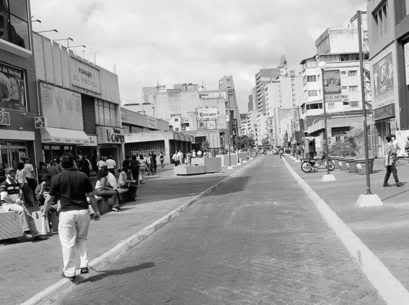
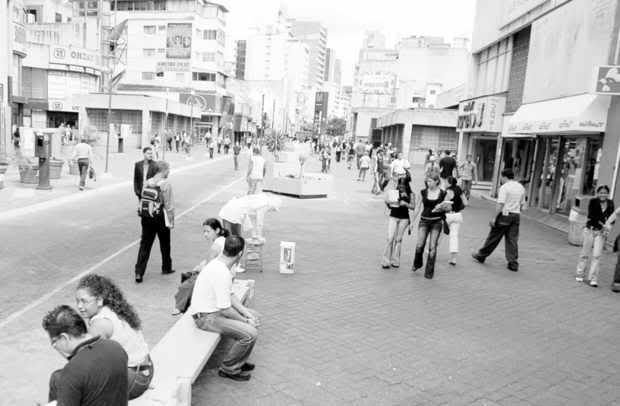
If no one figures it out, that is ok. I'll post an update later with the answer.
UPDATE:
As has been guessed, this is indeed the Sabana Grande, the main boulevard through Caracas. Like much of Venezuela it was once one of the nicest streets in all of Venezuela. Like much of Venezuela over the past decades it had declined and was taken over by street vendors. In fact it was so full of street vendors that is was often unrecognizable. Now, with Venezuela's revival it too is now being revived. Another good acheivement for Venezuela.

|


If no one figures it out, that is ok. I'll post an update later with the answer.
UPDATE:
As has been guessed, this is indeed the Sabana Grande, the main boulevard through Caracas. Like much of Venezuela it was once one of the nicest streets in all of Venezuela. Like much of Venezuela over the past decades it had declined and was taken over by street vendors. In fact it was so full of street vendors that is was often unrecognizable. Now, with Venezuela's revival it too is now being revived. Another good acheivement for Venezuela.

|
Tepui fever
Simon Romero, the New York Times reporter assigned to Venezuela and the other Andean countries, took a break from politics long enough to do some exploring of Venezuela's huge and spectacular table top mountains called "tepuis". He published his finding in today's travel section:
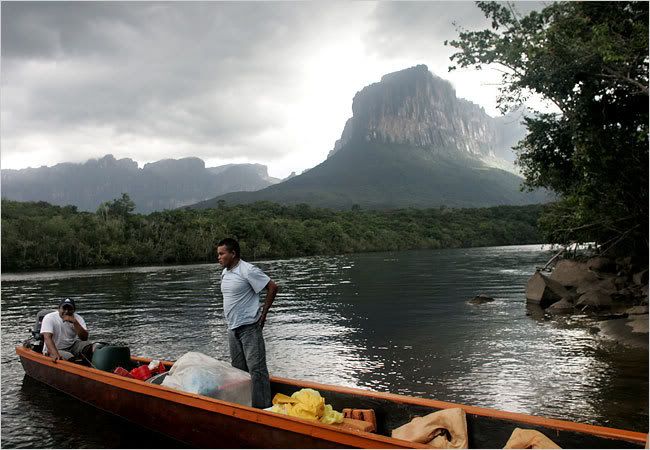
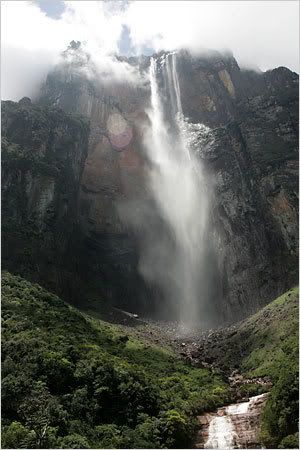
You can read the rest of the article here.
Indeed Angle Falls is spectacular. It is also relatively easy and inexpensive to get to. And not to inject too much politics into what should be a non-political post it also gave me my first glimpse into how the Venezuelan business class operates.
A good while back I was making my first trip ever to Angel Falls. I didn't quite know how to go about it. I had several guide books, such as Lonely Planet, which said that one should just go to the airport at Ciudad Bolivar (about a half day bus ride from Caracas) and book a trip with one of the tour operaters there.
I was a little nervous about just showing up at there and thinking I could get on a tour. So I went to several travel agencies in Caracas and inquired about tours to Angel Falls. They invariably tried to get me to purchase tours they were selling that would included flights from Caracas and would cost at least $2,000 per person. That was outside my budget and much more than what the guide books indicated I could get in Ciudad Bolivar. So I asked the travel agents about the agencies in Ciudad Bolivar, even showing them the pages in the books referring to them, and they invariably told me that those agencies didn't exist, or they had never heard of them, or that they had gone out of business.
Still given the extremely high prices they were quoting me and the bad experience of a Venezuelan travel agency having sold me a way over prices tour package once before, I decided to risk it, take a bus to Ciudad Bolivar, and see what happened.
When I got there I took a taxi to the airport and there, right in the terminal, where all the agencies running tours to Angel Falls that the people in Caracas had sworn didn't exist. I bought tour from Bernal Tours (which was actually founded by a Peruvian and is still there) for about $150, had a great trip to Angel Falls, and caught a bad case of Tepui fever. When I told the person selling me the tour that everyone in Caracas had told me his agency didn't exist he just smiled and told me that is the way people in Caracas are - there is no lie too big if it helps them make a quick buck.
So if you haven't already been I highly recommend that you get to Ciudad Bolivar and take a trip to Angel Falls. I can guarentee you, it may be the first time you will see a Tepui, but it won't be your last - as it seems it won't be for Romero:
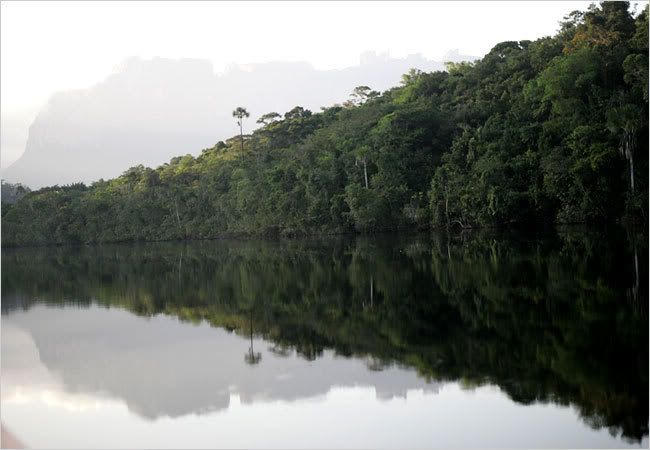
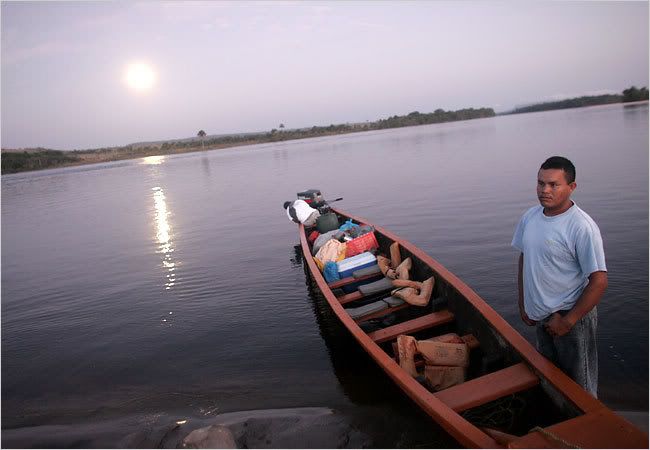
Clearly he has a bad case of "Tepui fever". This is an ailment that afflicts people who have seen these stunningly massive flat top mountains only from below. The main symptom is an irrepresable desire to see what is on top. There is only one cure known to man.
I look foward to Mr. Romeros report six months from now of what it was like to hike up Venezuela's Roraima Tepui. Then in a year or two we can get a further report when he hikes up the Auyan Tepui - the one Angel Falls is located on. He seems to have been impressed by being at the base of Angel Falls looking up. Actually the much more impressive view is at the rim of the Tepui right where the water takes its 3,000 foot plunge.
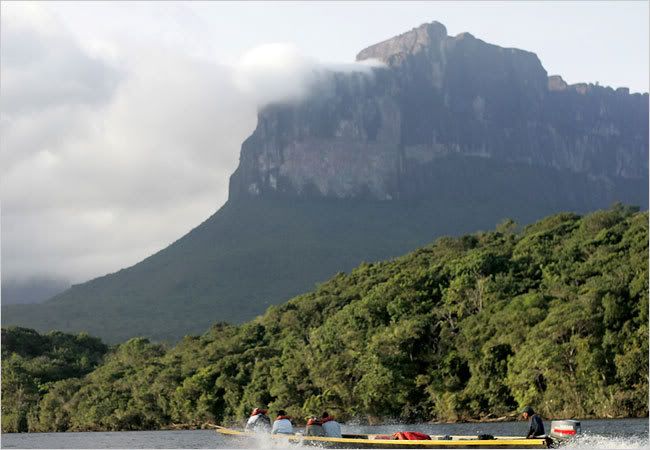
|

THE wooden canoe, a curiara in the language of my Pemón Indian guides, winds through the rapids of the Carrao River in southeast Venezuela. A drizzle lets up as the sun rises, revealing the misty escarpments of Auyan-tepui. Then, abruptly, the tepui — a Pemón word for the majestic sandstone mountains in this wide swath of jungle and savanna — comes into magnificent relief. It is easily one of the most impressive sights I’ve ever encountered.
But the best part is yet to come: Angel Falls, the world’s tallest waterfall at 3,212 feet (almost 20 times the height of Niagara Falls), named in honor of Jimmie Angel, the Missouri-born bush pilot who crash-landed his turboprop nearby in an ill-fated search for gold in the 1930’s. Though the Pemón Indians were surely among the first to contemplate the waterfall, the name Angel Falls stuck after word of the arduous 11-day trek of Angel’s traveling party reached the outside world. By 1949, the American photojournalist Ruth Robertson had measured Angel Falls for an expedition described in National Geographic, cementing the mystique of Venezuela’s tepui country.
Venezuela has done little to develop this corner of Bolívar State, and the flight from Puerto Ordaz, over thick jungle and sinewy rivers, to Canaima, an asphalt strip and collection of thatched huts that passes for an airport, attests to the region’s remoteness.
“I might have one of the most rewarding jobs in the world,” said Laszlo Miszlai, 36, the Venezuelan pilot of the Cessna Grand Caravan that swooped in for a dramatic view of Angel Falls before we landed. “I not only get to fly over the falls almost every day, but I get to see the awed expressions of our passengers.”
Beyond the polarizing political theater that defines Venezuela these days are places of intense beauty, from deserted Caribbean beaches to snow-capped peaks. Angel Falls, in the heart of Canaima National Park, a protected reserve about the size of Belgium, may top them all.

You can read the rest of the article here.
Indeed Angle Falls is spectacular. It is also relatively easy and inexpensive to get to. And not to inject too much politics into what should be a non-political post it also gave me my first glimpse into how the Venezuelan business class operates.
A good while back I was making my first trip ever to Angel Falls. I didn't quite know how to go about it. I had several guide books, such as Lonely Planet, which said that one should just go to the airport at Ciudad Bolivar (about a half day bus ride from Caracas) and book a trip with one of the tour operaters there.
I was a little nervous about just showing up at there and thinking I could get on a tour. So I went to several travel agencies in Caracas and inquired about tours to Angel Falls. They invariably tried to get me to purchase tours they were selling that would included flights from Caracas and would cost at least $2,000 per person. That was outside my budget and much more than what the guide books indicated I could get in Ciudad Bolivar. So I asked the travel agents about the agencies in Ciudad Bolivar, even showing them the pages in the books referring to them, and they invariably told me that those agencies didn't exist, or they had never heard of them, or that they had gone out of business.
Still given the extremely high prices they were quoting me and the bad experience of a Venezuelan travel agency having sold me a way over prices tour package once before, I decided to risk it, take a bus to Ciudad Bolivar, and see what happened.
When I got there I took a taxi to the airport and there, right in the terminal, where all the agencies running tours to Angel Falls that the people in Caracas had sworn didn't exist. I bought tour from Bernal Tours (which was actually founded by a Peruvian and is still there) for about $150, had a great trip to Angel Falls, and caught a bad case of Tepui fever. When I told the person selling me the tour that everyone in Caracas had told me his agency didn't exist he just smiled and told me that is the way people in Caracas are - there is no lie too big if it helps them make a quick buck.
So if you haven't already been I highly recommend that you get to Ciudad Bolivar and take a trip to Angel Falls. I can guarentee you, it may be the first time you will see a Tepui, but it won't be your last - as it seems it won't be for Romero:

Slowly, I ascended the tepui, grasping parts of tree trunks and branches to gain balance on the slippery mud and stones. Ahead, Mr. Jaramillo blissfully jogged up the path as if he were strolling on the savanna. Little by little, the thick trees above us began letting in more sunlight, raising the temperature to greenhouse levels. We glimpsed Auyan-tepui’s stone escarpment and, finally, the water falling more than 3,000 feet from the top of the soaring mesa.
But we still had about an hour to go before we arrived at Angel Falls. When we finally got there, the pool of cool water at the base of the falls was a welcome sight. I dove in, doing a backstroke as I gazed up at a cascade of water that doesn’t so much crash as separate into smaller falls and showers of mist as it descends in seemingly slow-motion. There were no souvenir stands or snack bars here, just a few boulders to sit on. All around us was dense green jungle, accentuating the isolation and benign neglect that has thus far prevented this place from turning into an easily accessible tourist destination.
A retired oil executive who made the trek to the base of Angel Falls with his wife and his teenage daughter were the only other Americans I encountered. A sprinkling of other nationalities was there, some Italians, Spaniards and a Serb. Some Venezuelans were there, too, lugging a bottle of Scotch whiskey and a bucket of ice.
Eventually, we hiked down the tepui back to the lookout point, where our guides prepared a lunch of chicken roasted on a spit over an open fire, accompanied by casabe, a hard bread made from manioc.
Later, in the canoe back to Ucaima, I stole a last glance at Angel Falls. I had gotten a taste of Venezuela’s legendary lost world and now I wanted more.

Clearly he has a bad case of "Tepui fever". This is an ailment that afflicts people who have seen these stunningly massive flat top mountains only from below. The main symptom is an irrepresable desire to see what is on top. There is only one cure known to man.
I look foward to Mr. Romeros report six months from now of what it was like to hike up Venezuela's Roraima Tepui. Then in a year or two we can get a further report when he hikes up the Auyan Tepui - the one Angel Falls is located on. He seems to have been impressed by being at the base of Angel Falls looking up. Actually the much more impressive view is at the rim of the Tepui right where the water takes its 3,000 foot plunge.

|
